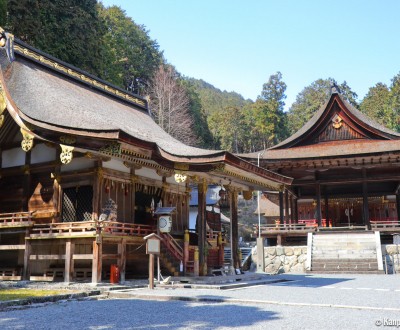Hiyoshi Taisha
🐒 The Monkey’s Shrine near Otsu
Hiyoshi Taisha is one of the most important Shinto shrines in Otsu, built at 381 meters above sea level on Mount Hachioji, in the Hiei mountains, in Sakamoto district. With a 2,100 year-long history, mentioned in Kojiki, one of the oldest Japanese chronicles, Hiyoshi Taisha is also the head shrine to a network of about 3,800 shrines, with various designations (Hiyoshi, Sanno and Hiei).
Hiyoshi Taisha is defined as a syncretic place of worship, merging Shintoism and Tendai Buddhism, in the celebration of the three sacred gods of the mountain, or Sanno Sansei: Shakanyorai, Yakushinyorai and Amidanyorai. This syncretic Buddhism was fully supported by the emperors of the Heian period (794-1185) and the shrine was built in the Hiei mountains to protect the northeastern entrance to the former capital Heian-kyo (today’s Tokyo).
Hiyoshi Taisha is also known as Sanno Shichisha, meaning "the seven Sanno shrines" as it includes two great main buildings (Higashi-hongu and Nishi-hongu) listed as Japan’s National Treasures, and five secondary pavilions.

🐵 The star of the shrine: Masaru the sacred monkey
Nowadays however, most of visitors are unaware of the shrine’s prestigious history and importance, and they come to worship Masaru-san 神猿舎, the monkey 🐒 god, messenger of the Buddhist deities and protector against demons. The Japanese characters used to write "Masaru" – a name including the kanji for "monkey" (猿 saru) - mean "to prevail" as well as "to be superior". "Masaru" implies the defeat of evil, and the advent of luck. The little sacred monkey is thus considered a lucky charm and praying it, thanks to O-mamori amulets, is said to ward off evil spirits.
Numerous representations of the little monkey can be found in Hiyoshi Taisha’s precincts. The great Romon Gate itself is protected by monkeys figured as Munamochi-saru (棟持猿 "ridgepole holding monkey"), whose position facing the four cardinal points while holding the roof symbolizes their power of protection.
The environment of Hiyoshi Taisha is favorable to real monkeys naturally living in the surrounding mountains. It is not unusual to spot some of them in the vicinity of the shrine, while they are collecting seasonal fruits.

🍁 A beautiful autumn walk under the koyo
Hiyoshi Taisha offers an easy walk in the forest, and some small inclines to reach all of the site's buildings. In autumn 🍁, at the end of November, the 3,000 Japanese maple trees turn red and amplify the beauty of the place. However, the shrine’s raw and buoyant, as well as soothing nature can also be enjoyed at any time of the year. It offers many shades of green in spring 🌸, a fresh tree cover from the summer heat, and a snow mantle in winter.
The most important festival of the year, Sannosai Matsuri, celebrates the three gods of the mountain, and takes place in mid-April. Impressive in the same fashion as Gion Matsuri in Kyoto, the inhabitants carry mikoshi portable shrines in an interesting parade.
Hiyoshi Taisha is Lake Biwa’s place of worship that cannot be overlooked, and is to be discovered along Sakamoto, the monks’ village near which it is located. A visit to Hiyoshi Taisha can thus be easily combined with Kyuchikurin-in Garden and the mystical Enryaku-ji temple.

